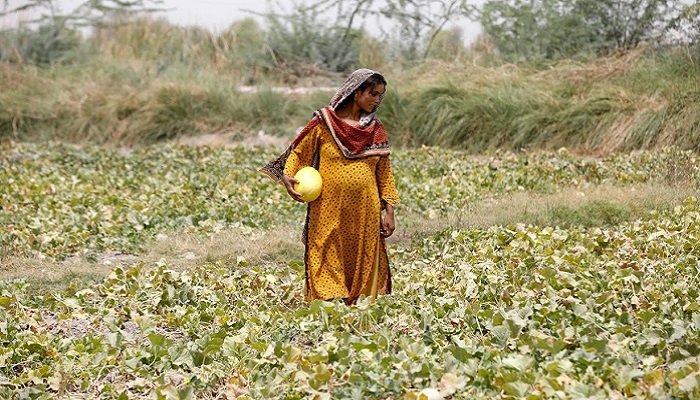Climate change threatens lives and Pakistan’s food security
This year’s floods have inflicted immense damage to Balochistan and Sindh, which will take the government years to rebuild, writes Dr Ameena Tanvir
August 23, 2022

Long denied and then ignored, climate change is now taking a toll on Pakistan as the country sits at high risk of being run out of water and braces for intense and unprecedented weather patterns.
Pakistan is breaking its own records of being one of the worst-hit countries by climate change, almost every year.
According to the Global Climate Risk Index, Pakistan ranked eighth most vulnerable country in the world.
In May, the UN enlisted Pakistan among the top 23 countries facing drought emergencies over the past two years. Between 1998 and 2018, the country is estimated to have lost nearly 10,000 lives to climate-related disasters and suffered losses amounting to about $4 billion from 152 extreme weather events.
Analysts have estimated Pakistan’s climate migrants over the past decade at around 30 million people. Severe weather patterns coupled with lack of readiness are not only endangering the lives of millions of residents but also leading to food insecurity and a dwindling economic outlook.
Although heatwaves had started impacting the country for the last many years, this year’s premature heatwave has made ripples, forcing millions to readjust or reduce their daily workload or life pattern.
The unprecedented and intense heatwave that began in as early as April also sent shockwaves to the country’s economic outlook, especially to Punjab. The province produces more than 50% of the total wheat of the country, but the premature heat resulted in early harvesting led to missing production targets.
Punjab witnessed an unprecedented and premature rise in temperature varying from 41 degrees C to 47 degrees C in different parts, shaving off the spring season completely this year. It is not that 47 degrees C in the country is an abnormal temperature; the problem is that wheat and other crops need certain temperatures at a certain time for their growth.
The extreme heat episode in March and April led to a significant reduction in the per acre yield from over 40 munds to 28 munds. In May, the federal government decided to import three million tons of wheat from the international market to meet domestic needs.
This year’s intense and blistering heatwave didn’t spare mango production either, as the country faced nearly a 50% drop in mango production. Punjab alone, which produces 70% of the total mangoes, faced a 60% drop in mango production during the 2022 season.
The ideal temperature for good flowering of mango must be 13 degrees C to 30 degrees C, but this year the temperatures in those days hovered around 40 degrees C.
Year-on-year temperature increases have brought plague after plague in rural and urban areas. In 2020, Punjab faced the most devastating locust infestation in nearly 30 years, which affected 15% of the area of the province. Experts believe that the rising temperature of the Indian Ocean is one of the main reasons for the invasion of locusts in the South Asian region.
Also, the increasing temperature is one of several reasons for deadly air pollution in the country. According to experts, rising temperature is intricately linked with the climate crisis because warmer temperatures create an environment for smog formation and can lead the air to stagnate – preventing dirty air from leaving an area. Air pollution thus exacerbates existing inequalities and paves the way for human rights violations.
Deteriorating air pollution is also leading to indirect costs such as lower labour supply and productivity, migration of skilled labour, and volatility in the financial sector.
Rising temperatures are not an exclusive or sole reason for low yield of several crops in Pakistan, but prolonged droughts and below-normal rains have their part to play as well. Despite having one of the world’s largest irrigation systems, water channels across Pakistan confronted acute water shortages due to less or below-normal rainfall from February through June of this year. Water reservoirs remained unfilled or partially filled leading to hampering economic activities.
Before the recent rains brought relief for the residents of Cholistan, Thal and other desert areas of the country, life was upturned, forcing hundreds and thousands of people to migrate with their cattle to greener pastures and urban centres in a desperate search for water. Although all provinces confronted acute water shortages as of late June, Sindh faced the worst of it with a record 40% shortage.
The Indus River System Authority (IRSA) expected a 22% water shortage for the Kharif season, but it turned out even worse with a water shortage of 38%.
The prolonged drought eventually ended with the beginning of the monsoon season in July, but heavy rains made things look even worse. Flash floods caused by abnormally heavy monsoon rains have killed over 550 people so far, with Balochistan among the hardest hit.
According to the National Disaster Management Authority (NDMA), July turned out to be the wettest month since 1961, with 181% more rain than average. Balochistan received 450% and Sindh 308% more rain than the annual average, the disaster agency said.
Unusual and torrential rainfall in Karachi caused havoc, forcing residents to stay at home on weekdays. The provincial government also announced a day off to cope with the heavy rainfall challenge. During the second spell of monsoon rains, the city received more than an entire summer’s worth of rain in one day. Over 50 casualties have been reported in Sindh.
Successive governments, on their part, avowed to mitigate climate challenges and keep the issue as one of the top priorities. But little has been done in this regard due to a lack of funding, attention and willpower.
This year’s devastating floods have inflicted immense damage to the infrastructure of Balochistan and Sindh. It will take the government years to rebuild resilient infrastructure since it is barely surviving a default-like situation currently. Lack of awareness among people and the absence of sustainable policies are some other factors that will keep Pakistan’s fight against the looming climate change challenge unaddressed at least in the foreseeable future.
The writer holds a PhD in South Asian Studies. She tweets @AmeenaTanvir
Originally published in The News









